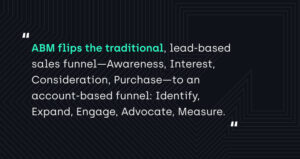Account-based marketing, more commonly referred to as ABM, continues to gain popularity. What is account-based marketing (ABM), and why are so many B2B technology companies using it?
“Account-based marketing (ABM), also known as key account marketing, is a strategic approach to business marketing based on account awareness in which an organization considers and communicates with individual prospect or customer accounts as markets of one. Account-based marketing is typically employed in enterprise level sales organizations.” – (Wikipedia)
That’s a succinct definition, but it doesn’t convey the true power of ABM and why so many tech marketers have come to rely on it. When Sangram Vajre, co-founder and CMO of Terminus, appeared on the Top 3 for Tech Marketers podcast (Top 3 Things the C-Suite Should Know About ABM), he defined ABM as “Focused B2B marketing, getting hyper-focused around your list of accounts and the people you care about; people you feel can benefit from your services.”
The History and Origins of ABM
The marketing concept that would eventually become known as ABM took shape in the late 1990s and early 2000s. In 2003 the Information and Technology Services Marketing Association (ITSMA) began using account-based marketing to describe “… a strategic approach that combines targeted, insight-led marketing with sales to increase mindshare, strengthen relationships, and drive growth in new and specific accounts.” ITSMA identifies four key principles of ABM as:
- Client-centricity and Insight Outside-in problem solving, not sales pitches
- Marketing and Sales Partnership Full collaboration for an integrated approach
- Reputation, Relationships and Growth Objectives beyond just near-term revenue
- Tailored Programs and Campaigns Personalized propositions, content, and “plays” to drive interest and engagement.
In 2004, a year after coining the phrase account-based marketing, the ITSMA published the paper Account-Based Marketing: The New Frontier, and Charles Doyle of Accenture presented the three objectives of client-centric marketing—perception management, establishing a differentiated position, demand generation–at the ITSMA Annual Conference. Interest in ABM took off, and in the years since marketers have both succeeded and struggled with efforts to effectively use it.
How ABM Flips the Sales Funnel
ABM flips the traditional, lead-based sales funnel—Awareness, Interest, Consideration, Purchase—to an account-based funnel: Identify, Expand, Engage, Advocate, Measure. That flip creates a more holistic view of marketing, positioning customer accounts as opportunities for upselling and cross-selling for maximum value. What’s involved with each step of the ABM funnel?

- Identify Pinpoint accounts not only the accounts with the highest ROI potential, but the most effective strategy for reaching them.
- Expand Conduct research to learn as much as possible about the targets accounts to know what matters most to them at any given time.
- Engage After launching a campaign, monitor the feedback and responses to fine-tune account-specific messaging, content, and campaigns.
- Advocate ABM account leads relay account-specific interactions to sales, marketing, and executives.
- Measure What’s measured is what matters, so it’s critical to track and report impact to gauge the ROI of both time and money.
What are the Benefits of Account Based Marketing?
ABM advocates often cite the method’s ability to target larger accounts that have long sales cycles and potential for larger, per deal amounts—think slow burn with higher return instead of turn and burn with lower return. The advantages ABM has over traditional B2B marketing approaches include:
Personalized Communications
In his conversation with Renee Yeager, Vajre explained that in B2B we’re not talking to one; we’re talking to multiple or many. That creates a need to focus on humanizing marketing interactions to build more value for a brand. This is important because, as Vajre said, “… people believe in brand more than just technology.”
The most effective ABM efforts manage to abandon any generic communications and instead use personalized messages created specifically for a target account. What’s learned about the target account in the Expand stage of the funnel is used to inform communications so they address specific, known needs of the account.
Aligning Sales and Marketing
Anyone in either sales or marketing knows how difficult it can be to align the two teams, but account-based marketing makes it much easier, and more fulfilling, for both. As Vajre said, “At the end of the day Sales is closing the deal. Marketing’s job is to bring the horse to water.”
Sales and marketing work together from the earliest stages ABM to identify target accounts, then continue to collaborate on campaign specifics, reporting progress, and ensuring prospects become customers.
Shortening the Sales Cycles
Tech buying committees are a very real hurdle to closing a sale, slowing the sales process as the decision to buy (or not) makes its way from lower to higher level decision-makers. All prospects at all levels of an organization are nurtured, simultaneously, with ABM, so it has the ability to truncate what can be a painfully long sales cycle.
Clarity Around ROI
ABM is unique in its ability to deliver high ROI, due in large part to its inherent precision and measurability. A December 2021 report co-authored by ITSMA and ABM Leadership Alliance found that companies investing in ABM see substantial business results, with “72% of companies reporting greater ROI from ABM than other types of marketing.”1
Reduced Waste
Vajre points out that ABM lets marketing focus on targets identified by sales—accounts with higher potential—taking low potential prospects out of the mix and saving both time and money. This has the additional benefit of allowing marketing and sales to work together on how to create more personalized opportunities. In the end this approach drives both more sales and a higher value of sales as well as post-sale opportunities for upserving.
ABM Works. But how’s it done?
It’s safe to say that ABM isn’t a fad; it’s here to stay. And it’s here to stay because it works—according to ON24 companies using ABM generate 208% more revenue from marketing efforts.2 What are the tactics used for high-impact account-based marketing? We’ll explore that in the next installment of our ABM series.

